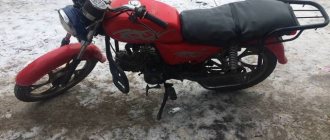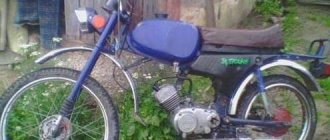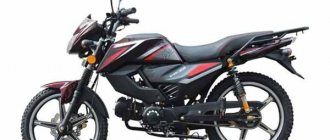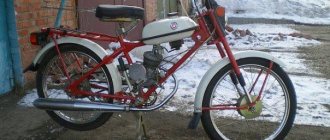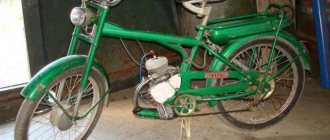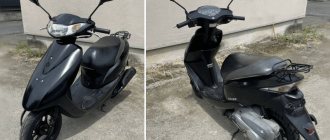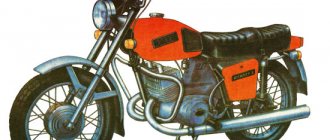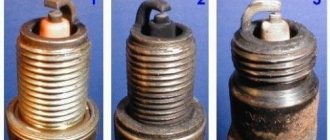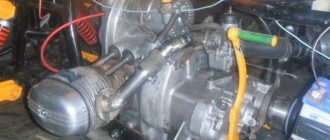Moped Karpaty 2 sport characteristics. Mopeds of the USSR
Domestic manufacturers of small-capacity motorcycles already had something to offer. Two large factories of that time - Riga and Lvov - had been producing Soviet mopeds since the beginning of 1960 and presented their new models with enviable regularity. The unconditional dominance of “Java,” of course, greatly hampered the developers of domestic mopeds, but the products of these factories also did not gather dust in warehouses and had their own consumers.
The Lvov Motorcycle Plant (LMZ), which initially specialized in the production of trailers, began developing prototypes of mopeds in 1958, as the country’s leadership decided to devote all its efforts to the development of this area. LMZ already had experience in developing such products: in particular, the plant produced motorbikes V-902 and V-905, mopeds MV-044 (“Lvovyanka”), as well as mopeds MP-043, MP-045, MP-046 and MP -047. The end of the 50s was marked by the release of the first mopeds “Verkhovyna-3” (MP-048), which played a significant role not only in the history of the Lvov Motorcycle Plant, but also in the history of domestic motor vehicles of that time. The Verkhovina-3 moped, equipped with a 50 cc two-stroke engine of the Kovrov Mechanical Plant (Sh-51K) with a power of 2 hp, accelerated to 50 km/h. The cubic capacity, power and maximum speed were typical for mopeds, so the developers, first of all, attracted the attention of consumers to the improved appearance of the first “Verkhovyna”.
Unlike its predecessors, the Verkhovina-3 moped was equipped with wheels of a smaller diameter and a tubular welded frame, thanks to which it was possible to increase the structural strength and reduce the weight of the moped to 51 kg. “Verkhovina-3” boasted a comfortable fit and modernized front and rear forks. The rear fork was secured to the frame with bolts and threaded bushings, which reduced the degree of wear during swinging. The brake pads were equipped with protective stops into which compensating washers could be inserted and the pads could not be changed after 20 kilometers. Previously, brackets were welded to secure the fuel tank, but on the Verkhovina-3 moped, the tank was attached to the collar, which made it possible to avoid cracks that often formed at the places where the brackets were attached. “Verkhovina-3” underwent a series of tests: in particular, the moped had to cover more than 5,300 kilometers to demonstrate its reliability and ease of use. In the period from 1972 to 1974 from the assembly line and Verkhovyna-5. The Verkhovina-4 moped, which was equipped with a Sh-57 engine with a power of 2.2 hp, weighed 52 kg and accelerated to 50 km/h.
The greatest attention in this line was attracted by the moped “Verkhovina-6” (LMZ-2158), which belonged to a different category of motor vehicles. At Verkhovyna-6, the bicycle pedals were replaced with a kickstarter, so it was no longer a moped, but a classic mokick. "Verkhovina-6" was equipped with a two-stroke Sh-58 engine with a power of 2.2 hp. and a two-speed gearbox, which was controlled by the left steering wheel. The high handlebar of the Verkhovyna-6 moped and the elongated seat provided a comfortable fit, and the soft suspension and wide tires provided a comfortable ride on difficult sections of the road. This moped, like the one on Verkhovyna-3, had a trunk designed to hold 15 kg. The Verkhovyna-6 moped became 3.5 kg heavier, but this did not affect its maneuverability and speed characteristics (maximum 50 km/h). The Verkhovina-7 moped appeared in 1981 and received a new carburetor, a more powerful generator and a Sh-62 two-stroke engine with a contactless electronic ignition system. "Verkhovyna-7" with a kickstarter instead of pedals was also a mokick, but, unlike "Verkhovyna-6", it reached a maximum speed of only 40 km/h. Externally, the Verkhovina-7 mokick has been slightly transformed thanks to a new headlight, a rear light with a brake light and control instruments located on the steering wheel.
An excerpt characterizing the Carpathians (moped)
Front fork 1 — bolt М8Х1Х25; 2 - nut M8X1 3 - washer; 4 — front wheel axle; 5 — rod tip; 6 — rod; 7 — spacer sleeve; 8 — nylon bushing; 9 — rebound spring; 10- spring; 11 - guide; 12 - skeleton; 13 — headlight bracket; 14 - reflector; 15 - pin; 16-traverse upper; 17 - holder; 18- stem; 19 — cover; 20 bolt M8X1X25; 21 - cap; 22 - nut; 23 — bracket; 24 — front fork rod; 25 — upper cone; 26 — bearing; 27 — frame assembly; 28 — bellows;. For those who don’t know, the wear of the piston group is measured by washing the piston and cylinder from dirt and old oil residues, inserting the piston into the cylinder, orienting it in the cylinder as it should be on the engine, aligning its skirt with the edge of the cylinder and using a feeler gauge, measuring the gap between the skirt and a cylinder.
Write a review about the article “Carpathians (moped)” Technical characteristics
| Do-it-yourself moped repair in the Carpathians In 2 months, not a single breakdown, I plan to change the piston, paint and do a collective farm tuning, something like lift up the wings, change the handles, stick stickers. Number of cylinders - 1 Cylinder diameter, mm - 38 Piston stroke, mm - 44 Compression ratio - 7.7-8.5 Cylinder displacement, cm3 - 49.8 Maximum effective power of a run-in engine at a crankshaft speed of 4400-5200 min- 1, kW l. |
| Wikizero - Karpaty (moped) If the engine runs stably at low speeds, but stops at the moment of sharp opening of the throttle, enrich the mixture a little by screwing in screw 18. Grab the magneto with your hand and shake it, if there is play, and even more so, you will have to change the bearings - stabbing the engine, the work is dirty, but the engine is like new. |
- Electrical equipment - contactless electronic ignition system with alternator.
- Transmission - multi-disc clutch.
- Fuel capacity - 7 liters.
- The motor transmission ratio is 4.75.
- The same ratio from the gearbox to the rear wheel is 2.2.
- Carburetor type - K60V.
- The energy supplier is a 6 V AC generator with a power of 45 W.
- The filter element is air type with a paper filter.
- Gas exhaust - a muffler with partitions for throttling the exhaust.
- The fuel mixture is A-76-80 gasoline with oil (ratio - 100:4).
»Models
• The pads are welded to both pipes and to the edges of the engine mounts. » icon=»icon: diamond» icon_color=»#279FD9″]
Competitors
The unit received the closest competitor in terms of characteristics in the “face” of the Verkhovyna vehicle. The Karpaty moped’s ignition, clutch assembly, design and some other indicators were significantly superior to its rival. In addition, “Delta” and “Verkhovyna-7” competed with the vehicle in question. Although all components of these variations were modernized, preference was given to the “Carpathians”.
There are several reasons for this. Firstly, the price of the Delta was higher, and it was produced in Riga. Secondly, the improved Verkhovyna had a guaranteed mileage of 6,000 kilometers, and a service life before major repairs of 15 thousand. The Karpaty moped at the same time had eight and eighteen thousand, respectively.
More than one generation, especially in rural areas, has studied every cog in this unit. A brief overview of the location of the main elements:
- The air filter is located directly behind the carburetor.
- The gearshift control lever is on the left, the brakes on the right.
- Also on the steering wheel is the clutch handle, gas, and front brake.
It is worth noting that there is no electric starter, so a fairly popular way to start the engine was to activate it with a “push” or “claw”.
Modifications and years of production
Riga 24
- It’s also known as
“Delta”,
it’s very common, almost as well as the
“Karpaty”
, but now we’re not talking about them; we’re talking about
“Delta”
, a mass-produced mokik.
The last Deltas were produced in St. Petersburg and were equipped with D-16 engines. The Riga Deltas (early and late) have few differences: the engine is V50 or V501, the headlight is round or rectangular, the front wing is like on Riga-22, or its own, Delta; trunk - painted or chrome plated.
Neutral reviews
Advantages:
It’s an indescribable feeling when you drive it, even for 40-50 km. You can say with the breeze)
Flaws:
The disadvantages of it are that it heats up quickly, the muffler to the cylinder is poorly attached, I advise you to keep this in mind! Well, the piston itself is rings, but this is the case everywhere, in all mopeds they need to be changed! Thank you for your attention!
Hello everyone, Moped Karpaty is my first moped, I really like everything about it, I’ve ridden a lot of kilometers on it) but I had to sell it, I miss it and wish I sold it! I recommend it to everyone, it’s a good thing, but for teenagers. It’s an indescribable feeling when you drive it, even for 40-50 km. You can say with a breeze) The disadvantages of it are that it heats up quickly, the muffler to the cylinder is poorly attached, I advise you to keep this in mind! Well, the piston itself is rings, but this is the case everywhere, in all mopeds they need to be changed! Thank you for your attention!
Advantages:
Inexpensive Lightweight Excellent driving on Russian roads
Flaws:
Ignition problems Engine overheating problems
I bought this one last summer. I drove it for about 2 months and the engine began to overheat. No matter how much I tinkered with it, I still didn’t understand what the problem was. There were always problems with the ignition, the speedometer did not work. In general, if you buy it in excellent condition, you can travel for 3 months.
Nuances of repair work
Almost every owner could repair the Karpaty moped independently. Quite often it was necessary to rebuild the engine. No matter how difficult this work may seem, thanks to the simple design of the motor of the unit in question, everything could be done quickly and efficiently.
If the cause of the breakdown is the failure of the bearings, crankshaft, rings, the engine will need to be split. This is a relatively simple procedure, much more difficult to put everything back together correctly. Although, if you pay close attention to the process and recommendations in the instructions, everything is very real.
Gaskets for the muffler can be cut out of thick cardboard and lubricated with grease. Important: when tightening the nuts, it is necessary to maintain the optimal force, avoiding insufficient fastening or stripping the threads. The Karpaty moped runs on a mixture of gasoline and oil; there is no special oil receiver. The optimal fuel is AI-80.
Riga 24 Delta. Other parameters
Installing the cylinder - remove the rag from the hole in the crankcase; — install the cylinder gasket and cylinder; — place the gasket, cylinder head and evenly, crosswise, tighten the four fastening nuts in 2-3 steps; — tighten the bolt securing the cylinder head to the frame; - connect the carburetor; — connect the exhaust pipe, fuel line, spark plug wire; — after warming up and completely cooling the engine, tighten the cylinder head nuts. Bagration does not join for a long time, although this is the main goal of all commanders, because it seems to him that he is putting his army in danger on this march and that it is most profitable for him to retreat to the left and south, harassing the enemy from the flank and rear and recruiting his army in Ukraine.
Other parameters. Riga-26 mini
| Carpathians (moped) - Wikipedia (with comments) The high handlebar of the Verkhovina-6 moped and the elongated seat provided a comfortable fit, and the soft suspension and wide tires provided a comfortable ride on difficult sections of the road. Engine section 1 - piston; 2 — piston ring; 3 - finger; 4 — right crankcase cover; 5 - generator; 6 - crankshaft; 7 — speedometer drive; 8 — drive sprocket; 9 - secondary shaft. |
Neutral reviews • A distinctive feature of the B501 engine is the foot-operated gear shift.
Engine design V-50
Šiauliai Bicycle Motor Plant began production of a new V-50 engine with a displacement of 49.8 cm3.
It is intended for mokiks “Riga” and “Karpaty” (“Behind the wheel”, 1982, no. 7). In terms of power and economic parameters, the V-50 does not differ from the previous models Sh-62 (“Behind the Wheel”, 1983, No. 1) and Sh-62M. Power is 1.6-2.0 liters. With. at 4800-5200 rpm. However, serious improvements have been made to the design, which have significantly improved the consumer qualities of the engine, in particular operational reliability. Almost all main components and parts have undergone changes. Thus, in the gearbox the interaxal distance of the shafts has been increased, the gears are stronger than steel, and rolling bearings are used instead of plain bearings. The clutch now has three plastic discs. Its inner drum and the bearing of the lower head of the connecting rod became more reliable (thanks to the use of rollers with a diameter of 4 mm and a length of 8 mm). In addition, the diameter of the piston pin has been increased, which has a beneficial effect on the durability of the bushing in the upper head of the connecting rod, and in the future makes it possible to use needle bearings.
All these innovations aimed at increasing reliability naturally exclude the interchangeability of many parts between the Sh-62M and V-50 engines. However, when assembled, the latter can be installed instead of the previous Sh-62M and Sh-62 motors. Many of the parts most often replaced during maintenance and minor repairs remained unchanged. These are gaskets and seals, piston rings, parts of the clutch release mechanism, exhaust and intake systems, plastic clutch discs. In addition, the cylinder and its head, carburetor, and electrical equipment are interchangeable with the old model.
The new engine is started by a kick starter and is linked to a two-speed gearbox with manual shifting.
The engine is designed for use as a base model for various modifications. Work is nearing completion on the creation of options with foot gear shifting, with liquid and forced cooling, as well as with a check plate valve at the inlet. In the near future, these modifications will be mass-produced.
D. SHISHKOVETS, chief designer J. PLOTKIN, engineer of Siauliai
Engine design V-50:
1 - cylinder head; 2 - cylinder; 3 — left half of the crankcase; 4 — left crankcase cover; 5 — clutch; 6 — clutch release mechanism; 7 — drive gear (1} teeth); 8 — gear block (12 and 17 teeth); 9 — driven gear (57 teeth); 18 — secondary shaft; 11 — first gear gear |25 teeth); 12 — starting lever; 13 — kick starter spring; 14 — emphasis; 15 - sealing ring; 16 — trigger gear (24 teeth); 17 — ratchet clutch; 18 — ratchet clutch spring; 19 — shift clutch; 20 — kick starter shaft; 21 — second gear gear (20 teeth); 22 — leading leash; 23 — driven leash; 24 — speedometer drive gear (13 teeth); 25 — speedometer driven gear (18 teeth); 26 — driving chain sprocket (15 teeth); 27 - crankshaft; 28 - generator; 29 — right crankcase cover; 30 - right half of the crankcase; 31 — connecting rod; 32 — piston pin; 33 - piston ring; 34 - piston; 35 - spark plug.
1984N05P8
Greetings from the 90s: new moped “Karpaty-2”
Just recently I told you about the new moped “Verkhovyna-3”
1971, discovered in Latvia in the attic of a private house.
And so, just the other day, a subscriber wrote to me on Facebook
and said that at his dacha, in his garage, there was also a completely new moped produced by the Lvov Motorcycle Plant.
A classic garage find: a piece of a moped is visible behind a pile of junk
True, we were talking about a later model - “Karpaty-2”, approximately from the early 90s. The moped (or correctly - mokik) was located in a small village not far from Kyiv, so we decided not to hesitate and after a few days we set out to view the rarity. Moreover, we were lucky with the weather - a warm autumn day, Indian summer outside.
In the process of freeing equipment from the rubble of junk
Upon arrival, it turned out that the device was littered with a bunch of rubbish and various household utensils - it was almost invisible. I had to spend about 20 minutes sorting through these deposits of garage junk - it was a good warm-up. But when we finally got to the bottom of the coveted technology, joy knew no bounds - completely new “Karpaty” pink-brick colors appeared in front of us.
The area has been cleared - now you can examine the device in detail
Having rolled out the 2-wheeled dream of schoolchildren of the 80s and 90s onto the street, we began a detailed inspection. So, before us is the Karpaty-2 mokik (factory name LMZ-2.161), judging by the plate on the frame, manufactured in 1993, in completely new condition.
Late Carpathians-2 of unusual color
Seat upholstery in young leatherette leather - the work of the first owner
Factory tin plate with model name. Year of release: 1993
According to the seller, the moped belongs to his wife’s father, who purchased it in the early 90s at one of the national economic exhibitions that took place in the capital. After purchasing it, he drove it around the village only a few times, and then stored it in the garage, where it has been for the last 23 years.
In the entire Union, guys, there is no cooler moped than the Carpathians
The dream of schoolchildren of the 80-90s. There is no speedometer on this modification, so it is impossible to find out the exact mileage, but the condition shows that it is no more than 100 km
“Karpaty-2” is the last production model of the Lviv Motor Plant: produced from 1986 to 1997. In better times, the company collected about 300 thousand mokiks annually, but in the second half of the 80s, demand began to fall, and production dropped to about 120-130 thousand pieces per year.
Since 1989, the fenders began to be painted in the color of the frame, and before they were chrome
The Karpaty-2 model was produced until 1997
Despite the fact that this mokik was released after the collapse of the Soviet Union, almost all of its parts (tail light, headlight, spark plug) bear the “Made in the USSR” markings: apparently, the plant still had a decent supply of components.
Models[edit | edit code]
Models produced:
- “Karpaty”
(LMZ-2.160, LMZ-2.160C, LMZ-2.160-01) - Sh-58, S-62, S-62M or V-50 engine[3][4]. - “Karpaty-2”
(LMZ-2.161) - differed from the “Karpaty” model in the shape of the tank (there are no rubber bands on the tank, plastic covers on the frame (until 1986 there were small covers with the number “50”) and a rear square lamp. V engines were installed -50 (later V-50M) with manual gear shift or V-501 (later V-501M) with foot shift gear.[3][5].
- “Karpaty-2 Lux”
(LMZ-2.161L, LMZ-2.161L-01) - the “Karpaty-2 Lux” model was additionally equipped with a turn signal and a reinforced trunk, designed for a weight of 15 kg. The LMZ-2.161L-01 model was equipped with a V-50 or V-501 engine (later V-50M or V-501M).[3][5]. - “Karpaty-2 Sport”
(LMZ-2.161S, LMZ-2.161S-01) - this model was given a sporty look: an upper exhaust pipe with a protective casing (screen) installed on it, a handlebar with an additional jumper (like sports motorcycles) , the shape of the rear trunk and the front fender mounting have been changed. A yoke handle was installed between the rear light and the seat for easy carrying of the moped. The cars were painted red, orange, green, cherry, and beige[6]. The LMZ-2.161S model was equipped with a V-50 or V-501 engine (later V-50M or V-501M)[3][5].
Since 1984, it was planned to produce the Lvov moped (LMZ-2.170) with the M531/541 KG-40 engine produced by the German company Simson.
In the 21st century, “Karpaty” mopeds are shown in museums of Soviet vintage cars and in private collections.
The “Karpaty” moped was produced from 1981 to 1997 [7]. Differences of the Carpathians:
- Carpathians
From 1981 to 1985, the headlight was metal black with a chrome rim, the fenders were chrome, the side black plastic covers on the frame were stamped 50, the taillight was not square, the trunk was chrome. Carpathians of the first issues 1981-1982. had closed rear shock absorbers, the springs were not visible. The Sh-58 engine was installed only in 1981. From 1981 to 1982, the S-62 engine was installed. From 1982 to 1983, the S-62M engine was installed. Since 1984, the V-50 has been installed with thin gearbox shafts. Colors of Carpathian mopeds: Green, cherry, brick orange, red, blue. - Karpaty-2
From 1986 to 1997, a metal headlight with a chrome rim was installed until 1987, from 1988-1990. large plastic square headlight, from 1991-1997. — a small plastic square headlight. The wings were chrome until 1989, from 1989 to 1997 the wings were painted the same color as the frame, the side covers were massive without inscriptions, the taillight was square, the trunk was painted in the color of the moped. Colors of Karpaty-2 mopeds: Brick orange, cherry, dark red, green, yellow, blue, black. - Disadvantages of the Karpaty moped
.
According to the recollections of moped owners in the Carpathians in the 80s and 90s. The weak points on the Carpathians are the frame itself. The frame was made of low-quality steel of an unknown brand. Almost every frame was welded crookedly at the factory. If you look at the back of the moped, you could see the wheels were X-
som. The frame burst at the welding points. When welded again, it burst next to the new seam. All the engine mounts, rear fender mounts, and the steering column were cracked and torn off on the frame. The quality of the parts welded crookedly at the factory made itself known literally immediately. The frame of Karpat-1 before 1985 was stronger than after 1985. The frames of the Verkhovyna moped were much stronger and of better quality, both in metal and in welding areas. - Many boys of the 80s and 90s were left with the steering wheel in their hands and a scar on their face when jumping from a slide. In the Carpathians they almost never took part in cross-country racing. Karpaty could make a wave (as in the upper breakdance) if he was shaken well behind the wheel.
- Unsuccessful design of the driven star on the wheel as on the first models of Karpaty-1 (the star was rigidly screwed to the wheel through an aluminum triangle. The bolts were constantly unscrewing, the star was dangling, the bolts rubbed against the rear pendulum and the rear wheel jammed with known consequences, including falling, breaking off part of the secondary shaft from the engine together with the drive sprocket and part of the crankcase), and on the latter. Although Verkhovyna-3 of the first releases had a reliable unit, similar in design to Riga. But the plant went its own way, i.e. simplified the design.
- Advantages compared to the DELTA moped.
All Carpathian mopeds had a comfortable seat with a glove compartment with keys and a bicycle pump. Gas tank 7 liters.
Peculiarities
The early and late Riga Deltas have a few differences: the engine is B50 or B501, the headlight is round or rectangular, the front wing is like on Riga-22, or its own, Delta; trunk - painted or chrome plated. To seal, a gasket made of special cardboard is installed between the crankcase and the cylinder, and an aluminum gasket is installed between the cylinder head and the cylinder.
Comments 248 – Neutral reviews
Engine left view 1 - noise suppression tip; 2 — rubber-metal bushing; 3 - carburetor; 4 — filler plug; 5 — hole for checking the oil level; b — gear shift lever only for the V501 engine; 7 — drain plug; 8 - seal. But it’s not enough to say that we are retreating at an acute angle because the French are moving between both armies, this angle is becoming even sharper, and we are moving even further because Barclay de Tolly, an unpopular German, is hated by Bagration, who has to become under his command, and Bagration, commanding the 2nd Army, tries not to join Barclay for as long as possible, so as not to become under his command.
Crankshaft
The crankshaft was loose and needed to be replaced with a new one or just the connecting rod.
The threads for some of the bolts were torn off and to prevent the bolts from falling out, someone flattened them and hammered them in with a hammer. We did the same with the drain plug.
By and large, there is nothing more to say about this engine. In addition to these, there are many more jambs in it, and the site’s resources are not unlimited, so, perhaps, I’ll summarize.
I took all this junk apart, washed it, rejected the parts and made a list of what I needed to buy. And then incomprehensible conversations began, which I really don’t like: they say, “you repair it.” — What about spare parts? “Yes, you understand, there’s no money now, it’s a lot of money” (...)
I waited, I waited for the financial tranche, but it never came. I collected these shakes in a bag, threw them into the cradle and sent this “Karpacz” back to where he came to me from.
Contents – Neutral reviews
| Moped Karpaty 2 sport characteristics. Mopeds of the USSR If the engine stops at the moment of sharp closing of the throttle, the mixture becomes leaner. In a new engine, friction losses are higher than in a used one, and at low speeds it may operate unstably. Schematic diagram of electrical equipment 1 - generator; 2 — switch-stabilizer block; 3 — rear lamp; 4 — brake light switch; 5 - high-voltage transformer; 6 - candle; 7 — interference suppression tip; 8 — light switch; 9 — sound signal; 10 - headlight; 11 - engine switch. |
Notes[edit | edit code]
- ↑ Mopeds “Verkhovyna” and “Karpaty” (unspecified)
. Access date: March 9, 2011. - ↑ Evseev D.
Mokiki “Carpathians-2”, “Delta”. - RusAvtokniga, 2002. - 64 p. — (“Rocker”). — ISBN 5942280452. - ↑ 1234
Mopeds, mokicks. Design, maintenance, repair / comp. Bykov K. P., Grishchenko P. V., eds. Shlenchik T. A. - Chernigov: PKF Ranok, 2004. - 128 p. - (Soviet motorcycles). — ISBN 966-8185-04-8. - ↑ Mokik “Carpathians” (undefined)
. Access date: March 8, 2011. - ↑ 1 2 3
Mokik “Karpaty-2”, “Karpaty-2 Lux”, “Karpaty-2 Sport”
(unspecified)
. Access date: March 8, 2011. - ↑ "Karpaty-Sport" (undefined)
. Behind the wheel (November 1, 1984). Date accessed: January 3, 2021. - ↑ Mopeds of the Soviet era (unspecified)
. Access date: March 8, 2011. Archived July 22, 2012.
